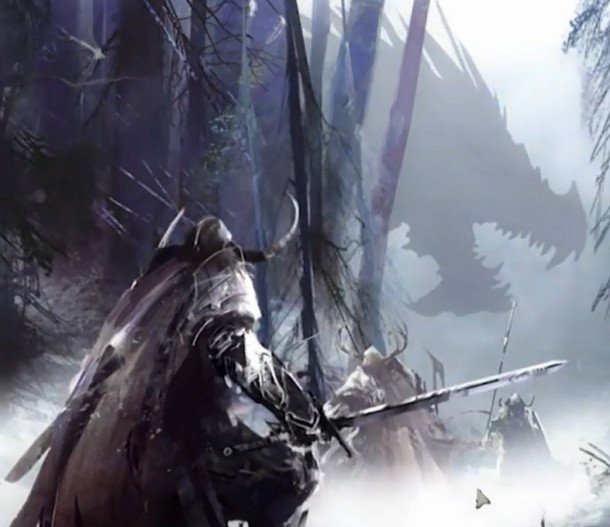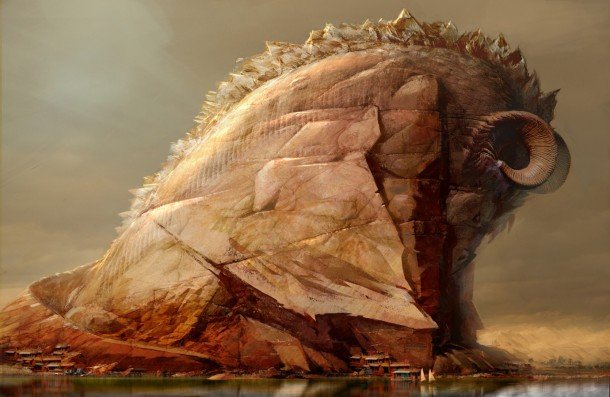Guild Wars 2 lore designers on rebuilding the world, and why they keep blowing up cities

Guild Wars 2 advances the story of Tyria 300 years beyond the first game, and in doing so substantially alters the status quo. The first game starred humans only: now, five races divide the world between them. The Charr - Guild Wars' orc equivalent, a rampaging horde that players worked together to subdue in the original - are now allies. Many of Guild Wars' major locations have been destroyed or reconfigured following a series of environmental disasters. During a recent trip to ArenaNet, I sat down with lore and continuity designers Jeff Grubb and Ree Soesbee to talk about the work that goes into building - and then rebuilding - a setting that has to hold the attention of players for years at a time.
The relative youth of the Guild Wars universe belies the enthusiasm that the community has for the vast amount of lore and backstory that ArenaNet have accrued over the years. Many players have invested heavily, mining out every scrap of detail they can find in the game's incidental environmental details. Subsequent tie-in novels and supplemental online information have been picked over for clues and dissected on fan-run discussion forums and wikis.
For the developers, staying in control of all that information is an ongoing and iterative process. "We're growing the world," explains Jeff Grubb. "We started out in 2007 with the end of [GW1 expansion] Eye of the North. We had a few hooks that we had set in the ground, we showed you the dragon Primordus and the Sylvari tree in the last cinematic.” Those hooks, however, were speculative: while players often assume that developers hold all the cards, the direction of a game can change dramatically as it's made. “We didn't know what the Sylvari were going to look like” Grubb continues, “we didn't know if we were even going to have Sylvari. We didn't know they were going to be a player race - but if we did, we had the hook."
In Guild Wars 2, Tyria is under attack by Elder Dragons - primaeval ancients with the power to lay waste to whole continents. At launch, one of these colossal dragons will form the final challenge for top level players. Others lie in wait, ready for whatever expansions may be coming down the line. ArenaNet have been teasing this narrative for years: the first bits of dragon evidence were planted in Guild Wars' Eye of the North expansion: frozen monsters in lakes, a distant ridge that could be the spine of a massive, buried creature. The developers have enjoyed watching players discover Tyria's secrets.
"The best argument I heard is that [the dragon in the frozen lake] is his head. That figure you see, that entire figure is just his head" Grubb says, recalling the way players rationalised the size of the easter egg against the supposedly vast Elder Dragon they were expecting. Later, ArenaNet clarified that the frozen dragon was 'just' a lieutenant. A fragment of the actual Elder Ice Dragon - a tooth the size of a bus - is visible in the Norn capital in Guild Wars 2.

Fans were digging for secrets long before ArenaNet started hiding dragons in the game. One player wrote an essay explaining the probable size and location of a landmark seen in the backdrop of one of Guild Wars: Nightfall's zones. "It's been a very long time so I can't give kudos to the guy who did it” says Ree Soesbee, “but he measured where the statue was in Elona, how far you could see it and where the shadow went and figured out how far across the ocean it was. It was amazing, I was looking at these mathematics thinking 'oh my god, you're awesome.'”
Creating a sense of mystery around a world is a kind of storytelling that MMOs excel at. Players have a bottomless capacity to not just uncover information but to invent it: to latch on to things and assign them importance even when the developers haven't. The expanse of an MMO and the long-term time investment they encourage make them an ideal breeding ground for fan attachment. I asked Jeff and Ree if Guild Wars 2's buried dragons were a deliberate attempt to provoke this feeling.
Keep up to date with the most important stories and the best deals, as picked by the PC Gamer team.
"Yes," Grubb says. "I'll do a call out here to when [Ree] did The Movement of the World which was article on the history of the world way back when - almost all of it is still applicable. There was a mention in passing of another dragon, another Elder Dragon, and we have not made any mention of it ever since."
"We know its name" Ree teases. "We know what we're planning with it. If you play Guild Wars 2 you'll see the influences of that dragon that are pretty clear. You can call them out, but most of that information is going to be saved."
"It's saved because my goodness we have a lot of Elder Dragons to be getting on with, and to provide freedom for the other creatives" Grubb explains. "From a design standpoint, we're iterative. We go back and we change and we evolve and we examine, we improve. The same thing applies to our story. As we build the story we go back and say 'okay does this work? How does this fit in? Here's a new piece of art. Here's a prop. Here's a new concept. How does that fold back into our basic themes of what we're doing?'"
The idea of grounding the story in Tyria's buried past has guided the game since its inception. "It's one of the things that we talked about really early on in the game when we'd just decided to do Guild Wars 2" Soesbee says. "We shut ourselves in a room and said 'what's it going to be about?' and started talking about dragons. We wanted to call back to the history of Tyria that we don't know anything about. I mean, what was here before the humans came? We wanted to make this a story of Tyria. Not of something coming into Tyria. Not of something absolutely new that you've never heard of that didn't make any sense."
"A lot of our history comes out of the first line of our timeline" Grubb explains. "When I came on board, it said 'last of the Giganticus Lupicus, the Great Giants, disappear from the Tyrian continent." I was asking people, 'What does this mean?' No one knew. Then we started evolving the story, taking hooks from the very first thing you encounter in the timeline. It gives a sense of continuity. It gives the sense that it's all one unified world. As Ree says, it's not like they got invaded by another dimension through space or something."

Making these ideas work requires clear communication, and the writing team maintain an internal wiki which is accessible to everyone working on Guild Wars 2. As the fiction expands, ArenaNet have become more and more responsible for living up to fan expectations, while still providing room for change later on.
"I think we are absolutely accountable to what we have said" Soesbee says. "If we said that [a character] wore a tricorner hat then he needs to be wearing a tricorner hat - but if we are careful and we just say he wears a hat then we can go back when we need it to be a tricorner hat and decide whether it is or not. We try to give as much detail as we can but we also try to leave some holes."
"I tend to not confirm or deny" Jeff says "and only say, 'what's in the world is what you see in the world'." Despite ArenaNet's willingness to write blog posts about their process and talk to the community, maintaining that community means telling as much of the story through the game as possible. “We also make use of the unreliable narrator” Grubb explains. “If someone says something in the world, he knows what he knows. But there may be other opinions.”
The more ArenaNet write and build, the less freedom they have to make changes. If you've ever wondered why evil wizards and desperate kings keep blowing up their own cities in the Guild Wars lore, this partly explains it. “We have these major occurrences that happen, and as a result it gives a chance for the artist to start anew” Grubb says. “You can still find the old Lion's Arch, it's underneath the water of the bay. But you also have the new Lion's Arch that's very different.”
In this case, the practical necessities of redesigning the world support the themes that the writing team are keen to express. "In the case where the vizier blew up Arah, or in the case where the fire was released in Ascalon - neither of those started out with a guy saying 'I think I'll blow up my city.' Both of them are a case of the cost of great power, 'what I'm willing to sacrifice'. And both of those individuals were willing to sacrifice everything and didn't really understand what 'everything' meant. I mean, when he unleashed the Foefire he wasn't thinking 'haha, I'll kill all my people' - he was thinking 'I'll do what it takes to kill all of theirs ."
"Going too far is a danger that pops up again and again" Jeff says. "Moderation in all things." I asked the pair of they were happy for that to be Guild Wars 2's after-credits message. "The after credits message is everything's better when your friends are with you." Ree says. "In moderation."
For more on the challenge of writing for an MMO audience, check out our interview with Ree Soesbee from earlier in the week. Guild Wars 2 week continues tomorrow.
Joining in 2011, Chris made his start with PC Gamer turning beautiful trees into magazines, first as a writer and later as deputy editor. Once PCG's reluctant MMO champion , his discovery of Dota 2 in 2012 led him to much darker, stranger places. In 2015, Chris became the editor of PC Gamer Pro, overseeing our online coverage of competitive gaming and esports. He left in 2017, and can be now found making games and recording the Crate & Crowbar podcast.


